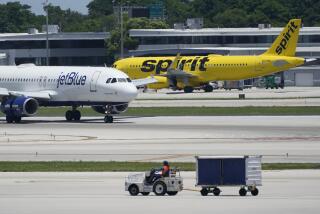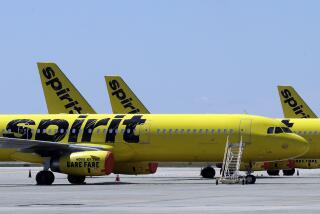This one should fly
THE NATION’S airline industry has been in a gradual recovery lately. But US Airways Group Inc.’s announced bid to acquire Delta Air Lines Inc. promises to set off a needed consolidation of the business that will make it better able to weather the next financial downturn. Let’s hope federal regulators don’t block such a transformation this time around.
That’s precisely what happened in 2001 when the Department of Justice ill-advisedly blocked the merger of US Airways and UAL Corp.’s United Airlines on antitrust grounds. The airline industry then had to confront an economic slowdown and the post-9/11 trauma with excess capacity, losing billions of dollars. Since 2002, four major U.S. airlines have sought bankruptcy protection; two (Delta and Northwest Airlines Corp.) are currently in Chapter 11.
US Airways says it will cut about 10% of the new Delta’s passenger capacity if the two airlines merge (under the Delta brand), mostly from routes that have redundant service. It also could close a few expensive hubs. Between 2001 and 2004, US Airways filed for bankruptcy twice. The airline probably would have shut down completely if scrappy America West Airlines hadn’t bought it in 2005. Delta says it will review US Airways’ offer but will go forward with its plan to emerge from bankruptcy as a stand-alone airline.
The federal government should carefully review the deal if it goes forward, as well as any other such mergers. (Continental Airlines Inc. and Northwest have been eyeing each other for years, and United Chief Executive Glenn Tilton has been a vocal advocate of more aggressive consolidation in the industry.) Some routes will need to be dropped, some gates surrendered to competitors.
But regulators need to recognize that the industry is changing. The country needs fewer first-tier coast-to-coast airlines with a broader reach at home and abroad. The problem with some major U.S. airlines is that they are simultaneously too small and too large. Beyond these, growing low-cost carriers such as Southwest Airlines Co. and JetBlue Airways Corp. handle nearly one-third of all domestic passengers, and will have about 50% of the country’s total market share in a decade.
Such nimble airlines are more capable than ever at filling niches created by the post-merger abandonment of routes by larger carriers -- or by their greedy overpricing in other markets.
If Congress really wants to help consumers and shore up the financial health of airlines, it should allow the entry of foreign carriers and investors, which it has repeatedly declined to do. This is a global industry, after all.
More to Read
Inside the business of entertainment
The Wide Shot brings you news, analysis and insights on everything from streaming wars to production — and what it all means for the future.
You may occasionally receive promotional content from the Los Angeles Times.










